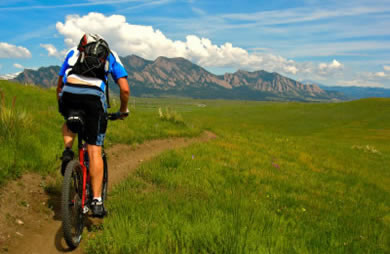By CD318156,
SparkPeople Blogger
7/11/2009
As many of you already know, I live deep in the heart of Texas. And while I would like to believe that it doesn’t get that hot, try telling me that this past Saturday when I had to get out well before sunrise to get my long run done. The reality is, when summer temperatures start to rise, my motivation to get out the door falls dramatically, especially when it is already 85 degrees at 5:30 in the morning.
But how does one manage to do fall marathon training, or for that matter any outdoor exercise, once the temps start moving up the thermostat.
Most running experts state the ideal temperature for long distance running is between 50-55 degrees Fahrenheit. However, here in Texas, that is only a small portion of our year. Once the temps start edging above these levels, performance levels start to decline. It has been shown for every 5 degrees above this range there is a 2% degradation in performance and this does not account for any other environmental factors such as humidity and ozone levels.
Below are some tips to take into consideration when exercising outdoors once the temps begin to climb.
Get out early before sunrise, if possible There are many sources of heat when one exercises outside. The most obvious being air temperature, but one cannot ignore the effects from the sun’s radiant heat, as well as the heat reflecting off the road surface. Add a little humidity and little to no air movement to the mix and you have the perfect storm for some very big issues. Heat cramps and other potentially dangerous heat-related illnesses, such as heat exhaustion and heat stroke are conditions to be noted.
Slow down Whether walking, running or cycling you will need to slow your pace and/or speed. If you have a race scheduled during warm temps understand that this is not the time to strive for a personal best. Your performance will be affected by the higher temperatures.
Run, walk, or cycle on a shaded route Direct heat can raise your body temperature by as much as 8-9 degrees higher than the ambient temperature, therefore, having a shaded route will help offset the effects of the direct heat. I also run routes where I have access to early morning sprinklers. This is a great way to keep cool.
Stay hydrated Wear a fuel belt or carry water with you. If you plan on being out for a long period of time consider carrying a sports drink with you.
Wear the proper attire Choose light colored clothing that wicks away sweat from the skin.
Wear a visor or a hat that allows for air flow. This will help keep intense heat off your head.
Wear your sunglasses Don’t forget to bring sunglasses with you. Eye strain can lead to tensing of the upper body therefore causing you to be less efficient in your running or walking.
Carry ice with you You can place the ice in a rag and wrap it around you neck. Carry it under your hat until you are ready to use it.
Listen to your body If you feel nauseated, dizzy, feeling foggy headed, or if you quit sweating this is a time to stop, sit down, drink water and seek help. This is why it is very important to run with a partner or leave a map with your family. And do not forget to wear your RoadID or carry some form of ID on your person as well as your cell phone.
According to information I received at the Road Runners Club of America Coaching Certification Class it takes the average runner 10 hours of running in the heat to acclimate to the heat, but this does NOT mean you will not need to take the necessary precautions mentioned above to stay safe. If all else fails, feel free to take your workouts indoors until the temperatures begin to drop. One should always err on the side of caution over risking one’s health.
Have you had to deal with the summer temperatures and if so what measures do you take to prevent problems? Have you been able to keep exercising outdoors this summer?
|
|

.png)






.jpg)












